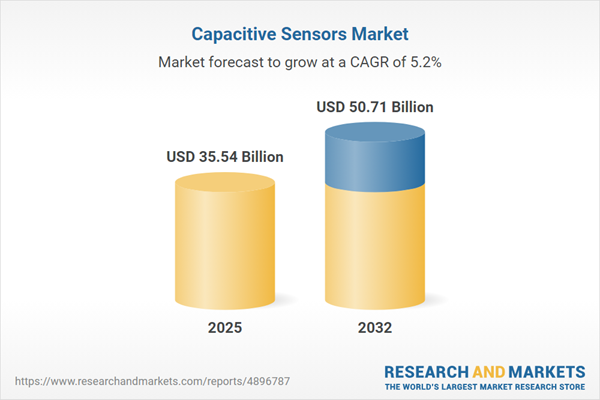Speak directly to the analyst to clarify any post sales queries you may have.
Capacitive sensors are redefining human-machine interaction, serving as vital enablers across automotive, industrial, healthcare, and consumer electronics sectors. For senior decision-makers, understanding market trends and the evolving value chain is crucial to capture emerging opportunities and manage supply chain disruptions.
Market Snapshot: Capacitive Sensors Market Size and Growth
The Capacitive Sensors Market grew from USD 33.81 billion in 2024 to USD 35.54 billion in 2025, advancing at a CAGR of 5.19% to an anticipated USD 50.71 billion by 2032. This growth trajectory is driven by technological advances, sector diversification, and increased emphasis on user-centric interfaces and industrial automation.
Scope & Segmentation
This report delivers a comprehensive view of the capacitive sensor landscape, analyzing opportunities and trends across application, technology, product, material, and regional adoption. Market coverage includes multiple industries and segments, each critical to sensor adoption and innovation:
- Applications: Automotive (infotainment, interior controls, safety systems), Consumer Electronics (laptops, smartphones, tablets, wearables), Healthcare (diagnostic equipment, medical devices), Industrial (factory automation, process control, robotics).
- Technology Types: Mutual capacitance, self capacitance, surface capacitive—each tailored for diverse use cases from multi-touch accuracy to cost-sensitive deployments.
- Product Categories: Touch panels, touch screens, touchpads—supporting variable device form factors and user expectations.
- Materials: Film (polycarbonate, polyethylene terephthalate), Glass (alkali free glass, soda lime glass); enabling innovative sensor substrates and displays.
- Regions Profiled: Americas (United States, Canada, Mexico, Brazil, Argentina, Chile, Colombia, Peru), Europe, Middle East & Africa (United Kingdom, Germany, France, Russia, Italy, Spain, Netherlands, Sweden, Poland, Switzerland, United Arab Emirates, Saudi Arabia, Qatar, Turkey, Israel, South Africa, Nigeria, Egypt, Kenya), Asia-Pacific (China, India, Japan, Australia, South Korea, Indonesia, Thailand, Malaysia, Singapore, Taiwan).
- Companies Covered: Texas Instruments Incorporated, Analog Devices Inc., STMicroelectronics N.V., NXP Semiconductors N.V., Microchip Technology Incorporated, Cypress Semiconductor Corporation, Renesas Electronics Corporation, Broadcom Inc., Semtech Corporation, Infineon Technologies AG.
Key Takeaways
- The expanding use of capacitive sensor technology underpins innovation in gesture control, precision measurement, and next-generation device interfaces.
- Miniaturization and flexible substrates are accelerating integration into wearable tech and curved displays, driving immersive and durable solutions.
- Embedded intelligence, including on-chip machine learning, enhances adaptive user experiences and supports condition-based maintenance for industrial environments.
- Risk management is becoming integral as shifting global trade, tariffs, and localization reshape procurement strategies and manufacturing footprints.
- Segmented offerings—by application, product type, and material—help market players address distinct regulatory and commercial requirements while improving operational agility.
- Collaborative partnerships between semiconductor firms, software developers, and materials specialists enable rapid technology alignment with industry needs.
Tariff Impact on Supply Chains
The upcoming United States tariffs are producing immediate challenges for businesses dependent on imported sensor components and raw materials. Organizations are actively diversifying suppliers, nearshoring production, and locking in longer contracts to stabilize costs, but they must balance these moves against potential risks in supplier qualification and regional infrastructure availability.
Methodology & Data Sources
This analysis utilizes a mixed-method approach. Primary interviews with industry executives, product managers, and engineering leaders yield qualitative insights into market drivers and priorities. Secondary research draws on peer-reviewed literature, patents, and standards documentation, while structured quantitative surveys and scenario analysis round out the empirical foundation. Peer validation ensures data robustness and actionable intelligence.
Why This Report Matters
- Enables executive leadership to benchmark emerging sensor technologies against evolving market requirements, informing product strategy and R&D roadmaps.
- Supplies actionable intelligence on market segmentation, competitive positioning, and regulatory impacts to optimize supply chain resilience.
- Equips procurement, innovation, and strategy leaders with evidence-based recommendations to navigate risks and capitalize on global growth drivers.
Conclusion
The Capacitive Sensors Market stands at a pivotal junction of technological progress and changing supply chain realities. For senior decision-makers, this report offers a roadmap to optimize investments, manage risk, and drive competitive advantage in a complex, fast-evolving landscape.
Additional Product Information:
- Purchase of this report includes 1 year online access with quarterly updates.
- This report can be updated on request. Please contact our Customer Experience team using the Ask a Question widget on our website.
Table of Contents
3. Executive Summary
4. Market Overview
7. Cumulative Impact of Artificial Intelligence 2025
Companies Mentioned
The companies profiled in this Capacitive Sensors market report include:- Texas Instruments Incorporated
- Analog Devices, Inc.
- STMicroelectronics N.V.
- NXP Semiconductors N.V.
- Microchip Technology Incorporated
- Cypress Semiconductor Corporation
- Renesas Electronics Corporation
- Broadcom Inc.
- Semtech Corporation
- Infineon Technologies AG
Table Information
| Report Attribute | Details |
|---|---|
| No. of Pages | 185 |
| Published | October 2025 |
| Forecast Period | 2025 - 2032 |
| Estimated Market Value ( USD | $ 35.54 Billion |
| Forecasted Market Value ( USD | $ 50.71 Billion |
| Compound Annual Growth Rate | 5.1% |
| Regions Covered | Global |
| No. of Companies Mentioned | 11 |









